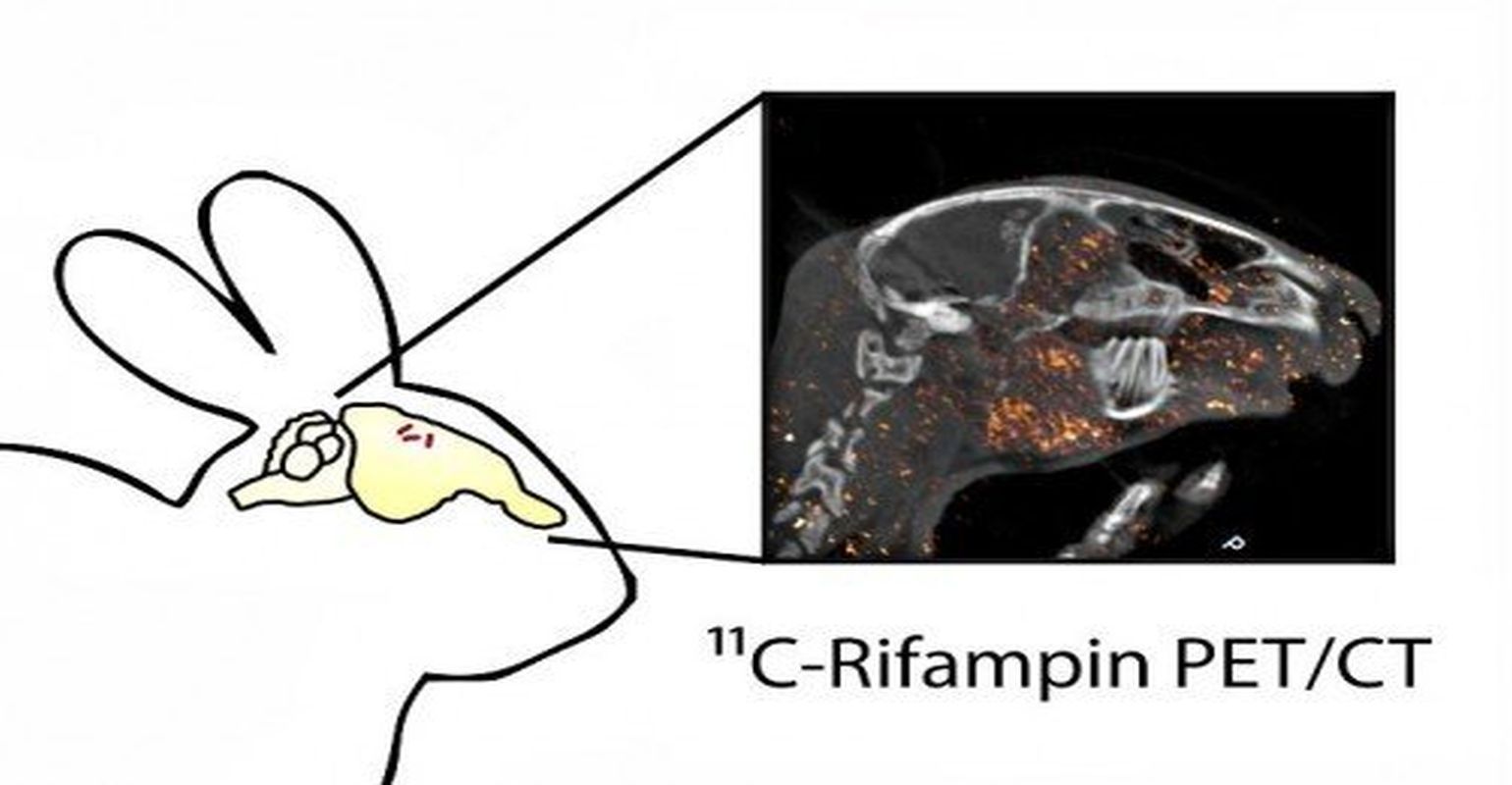PET Imaging Tracks Antibiotic Penetration Into Infected Brain Lesions for Treatment of TB Meningitis

Tuberculosis meningitis causes life-threatening inflammation of the membranes in the brain and spinal cord. Treatment is difficult due to the inability of drugs to penetrate the blood brain barrier (BBB). Now researchers are using non-invasive PET imaging to measure antibiotic concentrations in infected brain tissue with the goal of optimizing TB meningitis treatment.
TB infection usually begins in the lungs, but the infection can progress to the brain, where the slow progression of the disease hampers the ability to identify TB meningitis in its early stages. Progression of TB infection from the lungs to brain is more common in vulnerable populations such as children and individuals with HIV infection. Despite receiving the current standard of treatment and care, more than half die or have significant neurological injury which lasts a lifetime and is especially tragic when it occurs in young children.
“A central problem in treating TB meningitis,” explains Tatjana Atanasijevic, PhD, analyst for the NIBIB program in Molecular Probes and Imaging Agents, “is that antibiotics are unable to efficiently penetrate the BBB and the amount of penetration can vary from patient to patient, resulting in a lack of precision in attempting to treat this serious disease.”
Approaches used to measure antibiotic concentration include sampling the cerebrospinal fluid in the brain or spinal cord, which while generally safe, may not accurately reflect antibiotic concentrations in the brain. Biopsies of brain tissue have been done, but because they are extremely invasive and dangerous, are rarely performed. Additionally, this only provides a single timepoint dose measurement, which gives extremely limited information in terms of how the treatment is progressing over the year-long course of antibiotics.
To address this difficult problem, researchers at Johns Hopkins University School of Medicine led by Sanjay Jain, MD, director of the Center for Infection and Inflammation Imaging Research, have developed a non-invasive imaging strategy to accurately monitor antibiotic concentrations in the brain, which is an essential tool in the effort to optimize treatment for TB meningitis.
The research team developed a model of TB meningitis in rabbits for their experiments. The rabbits were treated with the antibiotic rifampin and also imaged using radioactively labeled (11C-rifampin). The radioactive carbon atom (11C) that was added allows the 11C-rifampin to be non-invasively visualized using positron emission tomography (PET).
Rabbits with experimentally induced TB meningitis were treated with 11C-rifampin injected into their bloodstream. PET was used to monitor how much 11C-rifampin made it into the brain over the first six-weeks of TB treatment. the overall goal was to determine the ratio of rifampin getting into the brain lesions compared to the amount of rifampin in the blood.
The results demonstrated that rifampin penetration into the brain was limited, and brain lesions in different locations in the same animal had different rifampin concentrations. Additionally, the movement of 11C-rifampin into the brain dropped-off dramatically two weeks into the treatment. The accuracy of the PET imaging was confirmed by direct postmortem measurements of rifampin in rabbit brain tissue throughout the course of the experiment. Importantly, levels of rifampin in the rabbit brains matched levels in post mortem tissue demonstrating that PET imaging of 11C-rifampin is a reliable technique for tracking antibiotic penetration into the brain.
“Currently, the only way to increase antibiotics in the brain is to increase the amount of drug given to the patient,” explains Jain. “However, we can’t just pump a ton of antibiotic into an individual, as that is toxic to the system. Our non-invasive measurement of antibiotic concentration in the brain will allow us to set a minimum rifampin dose needed to maintain effective treatment levels for TB meningitis.”
Having demonstrated successful antibiotic monitoring in the rabbit model, the researchers performed first-in-human studies in a 24-year-old female with TB meningitis. PET imaging was safe, without adverse effects and confirmed the findings observed in the animal studies. Finally, modeling the animal and human data, done in collaboration with researchers at the University of Maryland, allowed them to determine that a dose of more than 30 mg per kilogram would be needed to achieve consistent therapeutic level of rifampin in the brain.
“The rabbit study led the way to a very encouraging result in our first human subject. We now plan to use the PET system to determine the optimal dose of rifampin as well as other antibiotics for not only TB, but other infections such as MRSA,” explains Jain. “The goal is to incorporate imaging into precision medicine for infectious diseases. We believe this new approach could be tailored to individual patients at risk for treatment failure or those requiring optimized or prolonged antibiotics.”
The research team is also adapting their imaging-based precision medicine approach specifically for children, a “vulnerable and understudied population,” said Jain., “Such technologies may prove to be even more valuable for the infectious diseases that are particularly problematic in children.”
The study is reported in the December issue of Science Translational Medicine. This work was funded by the National Institutes of Health through a Director’s Transformative Research Award R01-EB020539, R01-HL131829, R01-HD069562, and K12-HD047349. Additional support was provided through a ‘Stimulating and Advancing ACCM Research’ [StAAR] grant from the Department of Anesthesiology and Critical Care Medicine, Johns Hopkins Medicine, and the Johns Hopkins All Children’s Hospital Foundation Institutional Grant Program.
Reference: Noninvasive 11C-Rifampin Positron Emission Tomography Reveals Drug Biodistribution in Tuberculous Meningitis. Elizabeth W. Tucker, Beatriz Guglieri-Lopez5, Alvaro A. Ordonez, Brittaney Ritchie, Mariah H. Klunk, Richa Sharma, Yong S. Chang, Julian Sanchez-Bautista, Sarah Frey, Martin A. Lodge, Steven P. Rowe, Daniel P. Holt, Joga Gobburu, Charles A. Peloquin, William B. Mathews, Robert F. Dannals, Carlos A. Pardo, Sujatha Kannan, Vijay Ivaturi, Sanjay K. Jain. Science Translational Medicine 05 Dec 2018: Vol. 10, Issue 470.